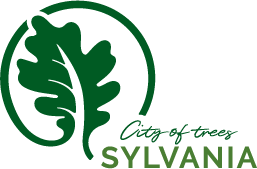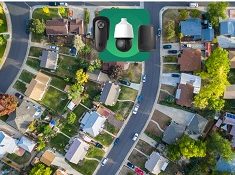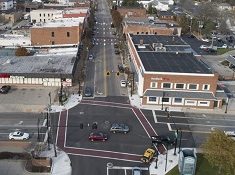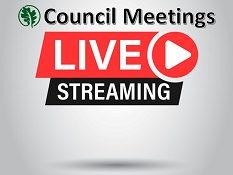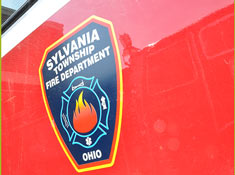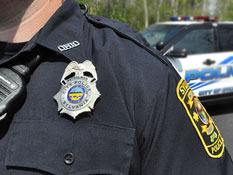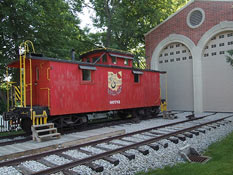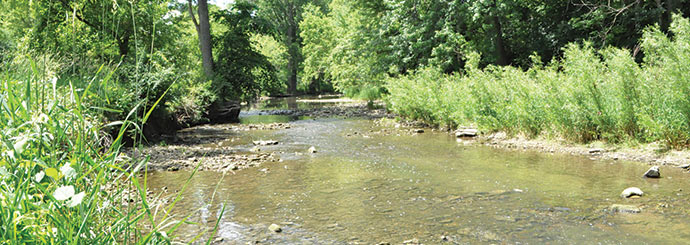
Ottawa River, Sylvania
Protecting our Waterways
As water flows over land, it collects soil, pet wastes, fertilizers, oils and other pollutants. Even if your house is not near a stream, ditch or river, the runoff will flow down the street into a ditch or storm drain that will eventually empty into a stream, taking soil and pollutants along with it.
By making wise decisions about lawn care and chemical disposal, you can help protect our water quality. Better water quality means protected sources of drinking water and a safe environment for you and your family.
Engineering Division
P: 419-885-8965 during normal business hours
E-Mail: city.public.service@cityofsylvania.com
Illicit Discharge Hot Line (police dispatcher)
After hours, weekends and holidays
P: 419-885-8900
The Homeowner’s Guide to Protecting our Waterways
Responsible Lawn Care
Pesticides and fertilizers can improve the appearance of the landscape; however, improper use of these chemicals can harm water quality. Here are some tips to protect water quality:
- Use fertilizers and pesticides sparingly.
- Keep fertilizer off paved surfaces. Sweep it back onto the lawn.
- Don’t fertilize before a rainstorm.
- Don’t bag your grass. Leave it on the lawn to reduce the need to fertilize.
- Mow at the proper height. Fescue thrives at three inches. Mowing any closer will create favorable conditions for weeds.
Improper discarding of grass clippings in areas such as ditches and streams will result in many problems within that particular area. Grass clippings contain a large amount of nutrients including phosphorus which can cause an increase in algae growth within the stream and receiving body of water. Nutrient input can reduce dissolved oxygen levels within a water system. Dissolved oxygen is necessary for biodiversity. Grass disposal on the banks of ditches and streams can kill vegetation which degrades bank stability and eventually will form blockages. Grass that is deposited on the ditch bottom can also cause a blockage in the stream.
The City of Sylvania, governed by an OEPA Phase II Stormwater permit, encourages the proper disposal of grass clippings including alternatives such as composting or mulching. Also, the City collects grass clippings as part of its green yard waste program. Working together, we can continue to improve the water quality of this delicate area.
Rain Gardens
Constructing a rain garden in your own back or front yard is one of the easiest and most cost effective things that a homeowner can do to reduce their contribution to stormwater pollution. Rain gardens capture rainwater from roofs, driveways, walkways and other pervious areas and divert it into nice looking, planted areas where the water can soak slowly into the ground, filter out contaminants and keep large quantities of clean water from going down the storm sewer. Rain gardens can cut down on the amount of pollution that could reach streams and creeks by as much as 30%.
For more information on rain gardens and how to make them visit the following web sites: http://www.raingardennetwork.com, http://raingardeninitiative.org
Proper Disposal of Trash and Chemicals
Don’t litter. Litter is one of the most unsightly forms of pollution in our local waterways and can easily be prevented. Carry a bag in the car for waste to eliminate the temptation to throw it out the window. Use an ashtray for ashes and cigarette butts, and dispose of them properly in a trash can periodically.
Proper chemical disposal is important for health and safety. Be sure to take chemicals such as paint, furniture stripper, fertilizers, pesticides, herbicides, batteries and antifreeze to the proper locations for disposal. You can get information about appropriate disposal of these materials from the Lucas County Solid Waste District at 419-213-2230 or Keep Toledo/Lucas County Beautiful at 419-213-2255.
Automotive Care & Maintenance
Mechanical Maintenance
Fluid spills and improper disposal of materials result in pollutants entering streams and lakes. Here are some ideas to protect our waterways during vehicle maintenance.
- Use drip pans and draining boards to capture solvents and oils for proper disposal.
- Use as little water as possible to clean spills, leaks and drips by using rags and dry absorbent material such as cat litter.
- Promptly take all fluids and batteries to the proper facility for disposal. Instant Oil Change at Monroe Street and Harroun Road will take used oil and fluids at no cost. Do not pour waste onto the ground or into storm drains.
Cleaning
When cars are washed in driveways and parking lots, the dirty wash water finds its way into the drainage system and ultimately into streams and lakes. Wash water contains pollutants such as oils and grease, phosphates (from the soap) and heavy metals, all of which have negative effects on water quality.
- Wash your car in the grass. The wash water will be treated by the soil, and the grass will benefit from the water.
- An alternative is to wash your car at a commercial car wash. There, the dirty water enters the sanitary sewer system, where it is treated before being released back into the stream.
Pick Up After Your Pets
Animal waste contributes harmful bacteria to local waters. These bacteria can pose health risks to humans and other animals and result in the spread of disease.
When taking the dog for a walk, take a few small bags and one large zip-lock bag. When doggie makes a deposit, turn a baggie inside out over your hand and use like a glove to pick up the waste. Transfer it to a larger bag and drop it in the trash. The plastic wrappers for newspapers also make great “deposit bags”.
Another option is to take a “poop-scoop” and plastic bags along and deposit waste in public garbage cans along the way.
What is an Illicit Discharge?
The Environmental Protection Agency defines an illicit discharge as any discharge to a separate storm sewer system that is not composed entirely of storm water runoff… with some exceptions. These exceptions include discharges from NPDES-permitted industrial sources and discharges from fire-fighting activities.” The illicit discharges could relate to industrial/business connection, accidental spills and construction activity. The final goal is to eliminate illicit discharges from entering the storm sewer system.
Some examples of illicit discharges include discharges from failed septic tanks, materials such as motor oil, radiator fluid, paint thinner, gasoline, paint and pet waste that have been illegally dumped into a storm drain or catch basin, or a chemical spill that reaches the storm sewer. These non-storm water discharges occur due to spills, dumping and improper connections to the municipal storm sewer from residential, industrial, commercial or institutional establishments.
The City of Sylvania has a separate storm sewer system. All of the storm sewers discharge into a stream or river. Therefore, it is important to protect our storm sewers and waterways from illicit discharges.
If you suspect an illicit discharge, please report it to the Sewer Division at 419-885-8957. Someone should be available during normal business hours. Also, feel free to contact the Illicit Discharge Hot Line (police dispatcher) at 419-885-8902 after hours, weekends and holidays.
The illicit discharge detection will involve multiple partners to identify problem areas, trace the source of the problem and eliminate the source. The parties involved will include the Department of Public Service, Sewer Section, Street Division, Zoning Division, Lucas County Health Department, Sylvania Township Fire Department and Ohio EPA.
For more information or to report stream pollution, contact the City of Sylvania Sewer Division at 419-885-8957.
Storm Water Facts
- A one-acre parking lot produces 16 times more storm water runoff than a one-acre meadow.
- Approximately 27,000 gallons of water fall on a one-acre yard during a one-inch rainfall.
- A single quart of motor oil dumped down a storm drain creates a two-acre oil slick.
- Seventy million pounds of active pesticide ingredients are applied to lawns in this country each year.
- Three billion fecal coliform bacteria are produced by an average-sized dog dropping.
- Recent research has discovered that urban stream quality begins to decline sharply once impervious cover in a watershed (streets, driveways, sidewalks and rooftops) exceeds 10%.
- Over one million acres of land are converted to urban use in the U.S. each year.
Post Construction Storm Water Management
The post-construction storm water management in areas undergoing new development is important to the City of Sylvania because the increase in sediment creates adverse effects on the storm sewer system and water treatment process. The post-construction impacts typically occur in two forms. The first impact resulting from new development is an increase of storm water runoff rates due to an increase in impervious area.
The second impact is the process of pollutants being transported by storm water runoff. The concern for the first impact is storm water quantity or capacity and the concern for the second impact is storm water quality. This control measure will combine structural and non-structural best management practices (BMP’s) to improve the storm sewer system and reduce pollutants entering the system.
The design of post-construction storm water controls shall be in accordance with the Ohio EPA’s Construction General Permit #OHC000003, the City of Sylvania’s Storm Water Management Plan and the codified ordinances of Sylvania Section 1181.06 Storm Sewers.
Design Resources
ODNR’s Rainwater and Land Development Manual (Ohio’s Standards for Stormwater Management Land Development and Urban Stream Protection)
Guidance Regarding Post-Construction Storm Water Management (Requirements of OhioEPA Stormwater Construction General Permit #OHC000003)
For More Information
Click on any of the links below to find out more about storm water runoff.
